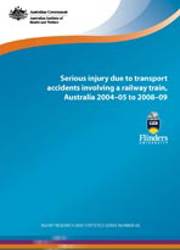Summary
This report presents information on cases of serious injury resulting in hospitalisation due to transport accidents involving a train for the five year period 2004–05 to 2008–09.
Serious injury due to transport accidents involving a railway train
Over the 5-year period, 868 persons were seriously injured in Australia due to transport accidents involving a train, an average of 174 per year.
Victoria (37.6%), New South Wales (30.0%) and Queensland (20.2%) accounted for almost 88% of these cases.
Age-standardised rates of serious injury due to transport accidents involving a train declined by an annual average of 5.1% over the 9-year period from 2000–01 to 2008–09.
Based on rail user data, approximately one rail user was seriously injured per 100 million passenger kilometres travelled in 2008–09.
Over the 5-year period, age-specific serious injury rates tended to be higher for those aged 70 years and over, for both sexes.
Rail users made up two-thirds (66.5%) of all serious injury cases due to transport accidents involving a train, with the most common circumstance of injury being injury while boarding or alighting from a train (27.3% of all serious injury cases) over the 5-year period of interest. Pedestrians injured in a collision with a train (15.1%) and car occupants injured in a collision with a train (12.1% of all serious injury cases) accounted for most of the non-rail user cases.
The mean length of stay in hospital for a transport accident involving a train was 7.0 days, which was markedly longer than the mean length of stay for all community injury hospitalisations (4.0 days).
Serious injury due to level crossing accidents
Over the 5-year period, 248 persons were seriously injured in Australia due to a level crossing accident, an average of 50 per year.
Victoria accounted for just over half (50.4%) of level crossing-related serious injury cases, followed by Queensland (24.2%), South Australia (10.1%) and New South Wales (9.7%).
Age-standardised rates of serious injury due to level crossing accidents declined by an annual average of 7.5% over the 9-year period from 2000–01 to 2008–09.
Over the 5-year period, serious injury rates, on an age-specific basis, were highest among young adults (20–24 years).
The most common circumstances of injury involved car occupants injured in a collision with a train (40.3%) and pedestrians injured in a collision with a train (31.5%).
The mean length of stay in hospital for a level crossing accident was 9.2 days, which was more than double the mean length of stay for all community injury hospitalisations (4.0 days).



